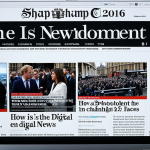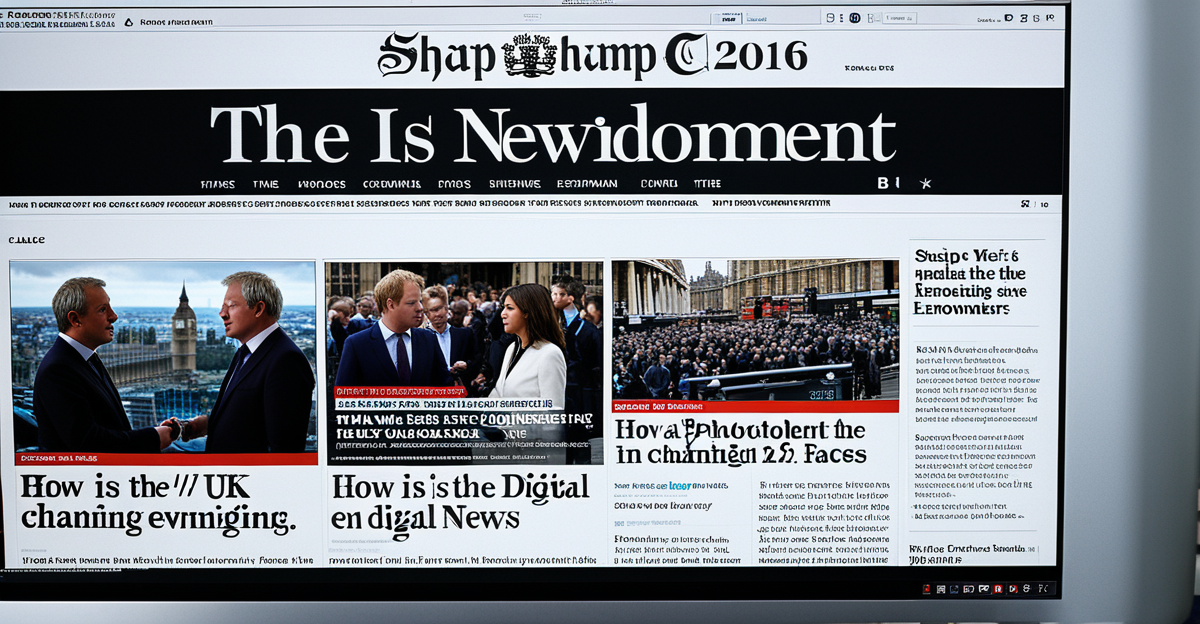The Shift from Traditional to Digital News in the UK
The digital news transformation UK has marked a significant evolution in how audiences consume information. Over the past decade, there has been a large-scale movement from traditional news sources, like print newspapers and broadcast media, toward digital platforms. This shift fundamentally alters the UK news media landscape by prioritising online accessibility and immediacy.
Data indicates that digital news consumption now surpasses traditional formats, with a growing majority of UK audiences turning to websites and apps for updates. Many legacy outlets, recognising these trends, have adopted digital-first strategies to stay relevant. Rather than abandoning print or broadcast entirely, they integrate multimedia content and real-time updates across digital channels.
Additional reading : How Can Recent Political Changes in the UK Impact Global Relations?
The competition between traditional vs digital news hinges on speed, convenience, and interactivity. While traditional platforms have long been trusted sources, digital news provides greater reach and personalisation. The UK news media changes continue to highlight the need for outlets to be agile, embracing technology and novel distribution methods to engage a more connected and mobile audience. This transformation reflects a broader shift in consumer habits and expectations within the UK news sphere.
The Impact of Social Media and Technology on News Consumption
Social media news UK platforms have become primary sources for how many people discover and consume news. Sites like Twitter, Facebook, and Instagram serve as hubs where users access headlines instantly, often before traditional outlets can publish. This shift highlights a clear trend in news consumption trends favoring speed and shareability over conventional formats. Algorithms play a crucial role by curating content tailored to individual preferences, thus personalising users’ news feeds. This personalised approach can increase engagement but also raises concerns about echo chambers and selective exposure.
Have you seen this : What Challenges Do UK Journalists Face in 2024?
The rise of mobile devices and news apps further accelerates this transformation in how news is accessed daily. Audiences increasingly expect on-the-go access, prompting UK news media changes to focus on optimising digital formats for smartphones and tablets. Mobile apps often include push notifications and multimedia elements, enhancing real-time news delivery and engagement.
Such technological advances have reshaped journalism itself, forcing outlets to rethink distribution and storytelling. In summary, social media and mobile technology have not only altered where and how news is consumed in the UK but have also influenced the speed, diversity, and personalisation of news content in significant ways.
The Impact of Social Media and Technology on News Consumption
Social media news UK platforms have reshaped the way audiences access and engage with news, becoming primary sources for many. Today’s news consumption trends reveal that a significant portion of the UK public relies on platforms like Twitter, Facebook, and Instagram to discover breaking news and share stories. These social networks influence not just what news users see, but also how they interact with it, embedding news firmly within everyday communication.
Technology and journalism UK now intertwine closely through personalised news feeds driven by sophisticated algorithms. These algorithms tailor content to individual preferences, often boosting engagement but also raising questions about echo chambers and selective exposure. Consequently, news is no longer a one-size-fits-all experience, but a customised daily digest, affected heavily by user behaviours and platform designs.
The rise of mobile devices and dedicated news apps further accelerates these trends. Mobile usage dominates the news consumption landscape in the UK, with users often accessing real-time stories on the go. This convenience encourages shorter, more frequent interactions with news, altering both the format and delivery methods that journalists and media outlets adopt to fit these new habits. Thus, social media and mobile technology together form the cornerstone of modern UK news media changes.
The Shift from Traditional to Digital News in the UK
The digital news transformation UK is fundamentally altering how news is created and consumed. In recent years, consumption of online news has surged past that of traditional sources like printed newspapers and broadcast television. This shift is driven by convenience, real-time updates, and multimedia integration offered by digital platforms. Data shows that the majority of UK audiences now prefer digital formats, reflecting a significant change in news consumption trends and habits.
Legacy media organisations face pressures to compete with agile digital outlets. They respond by adopting digital-first strategies, prioritising website updates, mobile apps, and social media presence to reach broader audiences. These UK news media changes go beyond simple platform shifts; they also involve rethinking storytelling techniques to suit digital environments, including video, interactive graphics, and push notifications.
Traditional vs digital news is no longer a straightforward contest between old and new; rather, it represents a complex integration where legacy brands adapt their trusted journalism within a digital framework. This transformation focuses on maintaining credibility while embracing innovation, ensuring that trusted news sources remain relevant as audiences move online.
The Shift from Traditional to Digital News in the UK
The digital news transformation UK marks a profound transition where audiences increasingly favour digital platforms over traditional print and broadcast media. Key data highlights this shift: digital news consumption now exceeds traditional sources, driven by the demand for immediacy and accessibility. Websites, news apps, and online portals have become primary channels for real-time updates, signalling a sharp decline in print circulation and scheduled broadcast viewing.
Legacy media outlets, recognising this seismic change, have adopted digital-first strategies to remain competitive within the evolving landscape. These strategies include integrating multimedia content, enhancing user experience on mobile devices, and providing continuous news updates. This hybrid approach maintains the trust associated with established brands while embracing the agility of digital formats.
The debate between traditional vs digital news often revolves around aspects like speed, convenience, and interactivity. Digital platforms excel in delivering personalised content rapidly, while traditional media retain strengths in credibility and comprehensive reporting. However, the ongoing UK news media changes require traditional outlets to continuously innovate and invest in digital infrastructure to meet modern consumption habits effectively.
The Shift from Traditional to Digital News in the UK
The digital news transformation UK signals a profound change from traditional journalism methods to digitally focused delivery. Key data reveals a rapid decline in print newspaper circulation and broadcast TV news viewership, while online platforms attract growing, diverse audiences. This pivot indicates that digital news consumption now constitutes the majority of UK news engagement, reflecting a redefined landscape shaped by immediacy and accessibility.
Legacy media organisations have responded with digital-first strategies, integrating real-time updates, multimedia storytelling, and interactive content to maintain relevance. This hybrid approach balances trusted journalistic standards with the dynamic nature of digital platforms. The tension in traditional vs digital news centers on preserving credibility while embracing innovative formats such as video streams, podcasts, and social media distribution.
These UK news media changes demand new operational models within newsrooms, including investment in digital infrastructure and skills. As audiences increasingly expect personalised, mobile-friendly news, traditional outlets must adapt to these evolving consumption patterns or risk obsolescence. Ultimately, the UK’s transition highlights the ongoing challenge of merging established journalism values with the pace and preferences of the digital era.
The Shift from Traditional to Digital News in the UK
The digital news transformation UK is underscored by significant shifts in audience behaviour, where consumption of online news now surpasses that of print and broadcast media. This change reflects extensive data showing a persistent decline in physical newspaper circulation and scheduled TV news viewing in favour of digital channels. These channels include news websites, mobile apps, and social media platforms that provide immediate updates and multimedia content.
The debate of traditional vs digital news emphasises distinct strengths and challenges. Traditional news sources maintain their authority and depth but often struggle to meet the demand for speed and customisation that digital formats offer. Digital outlets deliver real-time updates and interactive features, appealing to an increasingly mobile and connected audience.
Central to the UK news media changes is the adaptation by legacy media organisations. Established newspapers and broadcasters adopt digital-first strategies, prioritising digital content creation and distribution. This involves integrating video, interactive graphics, and push notifications to enhance engagement. Such strategies balance maintaining journalistic credibility with embracing innovation, ensuring that legacy brands remain relevant amid rapid technological evolution.
The Shift from Traditional to Digital News in the UK
The digital news transformation UK is characterised by a decisive move from print and broadcast towards digital platforms. Recent data confirms that online news consumption now surpasses traditional sources in both volume and frequency across the UK. This marks a pivotal development in UK news media changes, reflecting broader shifts in how audiences seek immediacy, convenience, and interactivity.
Legacy media outlets are central to this transformation. They have embraced digital-first strategies, prioritising online content through websites, apps, and social media integration. This pivot is not merely a platform change but involves reimagining workflows and storytelling to suit digital environments. Video, interactive graphics, and continuous updates play key roles in engaging modern audiences accustomed to real-time news.
The ongoing debate of traditional vs digital news illustrates contrasting strengths: traditional outlets continue to provide in-depth analysis and trusted reporting, while digital channels excel at speed and personalisation. Still, the pressure on legacy institutions to innovate is immense. Their future hinges on effectively balancing credibility with agility in response to evolving consumer habits and technological advances.
The Shift from Traditional to Digital News in the UK
A large-scale movement from print and broadcast media to digital platforms defines the current landscape of the digital news transformation UK. Key data highlights this shift: online news consumption consistently surpasses traditional sources, reflecting changing audience priorities toward immediacy and convenience. For instance, print newspaper circulations have sharply declined while digital visits on news apps and websites have surged.
The contrast of traditional vs digital news is visible in how content is delivered and consumed. Traditional media, once reliant on scheduled broadcasts or physical papers, now compete with the 24/7 news cycle driven by digital platforms. This competition places emphasis on speed, interactivity, and accessibility, elements inherent to digital formats.
Legacy UK media outlets have responded by adopting digital-first strategies, prioritising online updates and integrating multimedia such as video and interactive graphics. These UK news media changes illustrate an effort to maintain journalistic credibility while meeting new audience expectations. The transition requires newsrooms to restructure workflows, invest in digital infrastructure, and expand skill sets to thrive in a digital-first environment. Overall, this transformation signals a profound shift in the creation, distribution, and consumption of news across the UK.
The Shift from Traditional to Digital News in the UK
The digital news transformation UK represents a fundamental reorientation of how news is produced and consumed. Data consistently shows a declining trend in print newspaper sales and television news viewership, contrasted by a steady rise in online news engagement across websites, apps, and social media. This shift highlights changing news consumption trends where immediacy, convenience, and interactivity take precedence.
Legacy media play a pivotal role in responding to these trends. Traditional broadcasters and newspapers adopt digital-first strategies that prioritise digital content creation and distribution before print or broadcast. This includes real-time news updates, multimedia storytelling, and enhanced mobile experiences. Such UK news media changes require newsrooms to redesign workflows and invest heavily in digital infrastructure.
The ongoing debate of traditional vs digital news often centres on balancing trust and authority with speed and personalisation. While traditional sources maintain credibility through rigorous editorial standards, digital platforms excel at delivering rapid, tailor-made content to diverse audiences. Ultimately, the integration of these approaches is crucial for legacy outlets navigating the evolving UK news landscape amid persistent technological disruption.
The Shift from Traditional to Digital News in the UK
Audience preference in the UK has decisively shifted from print and broadcast toward digital platforms. The digital news transformation UK is evident in data showing online news consumption consistently outpaces traditional sources like newspapers and TV broadcasts. This marks a fundamental reorientation in how news is accessed, highlighting the demand for immediacy, interactivity, and mobile-friendly content.
Legacy media organisations face pressure to adapt as the news ecosystem evolves. To remain viable, many have adopted digital-first strategies that prioritise websites, mobile apps, and social media distribution. These strategies entail more than mere platform changes—they require embracing multimedia storytelling, such as video and interactive graphics, to engage digitally native audiences effectively.
The tension between traditional vs digital news lies in balancing credibility with speed and personalisation. Traditional outlets maintain authority through in-depth reporting, but digital platforms win users by catering to dynamic consumption habits that favour rapid updates and customised news feeds. The UK news media changes thus necessitate a blend of trusted journalism values and technological innovation, forcing newsrooms to overhaul workflows and invest in digital infrastructure to meet evolving audience expectations.
The Shift from Traditional to Digital News in the UK
The digital news transformation UK reflects a significant migration from print newspapers and broadcast media to digital platforms. Recent consumption data clearly shows that online news now exceeds traditional sources in reach and frequency. Audiences embrace the immediacy and accessibility of websites, mobile apps, and social media, which deliver constant updates and multimedia content tailored to user preferences.
Legacy media have been compelled to adopt digital-first strategies to remain competitive. This shift involves not only moving content online but also reconfiguring newsroom operations to prioritise real-time reporting and interactive storytelling formats such as videos and graphics. These UK news media changes ensure that traditional news brands maintain their relevance in a digital landscape dominated by rapid news cycles and personalised delivery.
The traditional vs digital news debate highlights contrasts: while traditional outlets are valued for credibility and in-depth journalism, digital platforms excel in speed, convenience, and customised user experiences. The success of legacy institutions now depends on their ability to integrate these strengths, investing in digital infrastructure and skills to meet evolving audience demands without compromising journalistic standards.
The Shift from Traditional to Digital News in the UK
The digital news transformation UK is characterised by a sweeping migration from print newspapers and broadcast media to digital platforms, fundamentally changing how audiences engage with news. Recent data clearly shows that online news consumption now exceeds that of traditional sources, driven by the demand for instantaneous access and personalised content. For example, digital visits via smartphones and desktops have surged, while print circulations continue to decline sharply.
Legacy media have actively responded to this shift by embracing digital-first strategies, prioritising real-time online updates, multimedia integration, and mobile optimisation. These changes in workflow reflect significant UK news media changes as traditional newsrooms restructure to include video, interactive graphics, and continuous content feeds. Digital formats enable more flexible storytelling, catering to the preferences of a connected, mobile audience.
The debate over traditional vs digital news hinges on the balance between credibility and immediacy. Traditional outlets continue to exert authority through investigative journalism and editorial standards; however, digital platforms dominate because of their speed, accessibility, and personalisation capabilities. Ultimately, legacy media’s survival depends on successfully blending these strengths—preserving journalistic integrity while innovating within the digital landscape.



